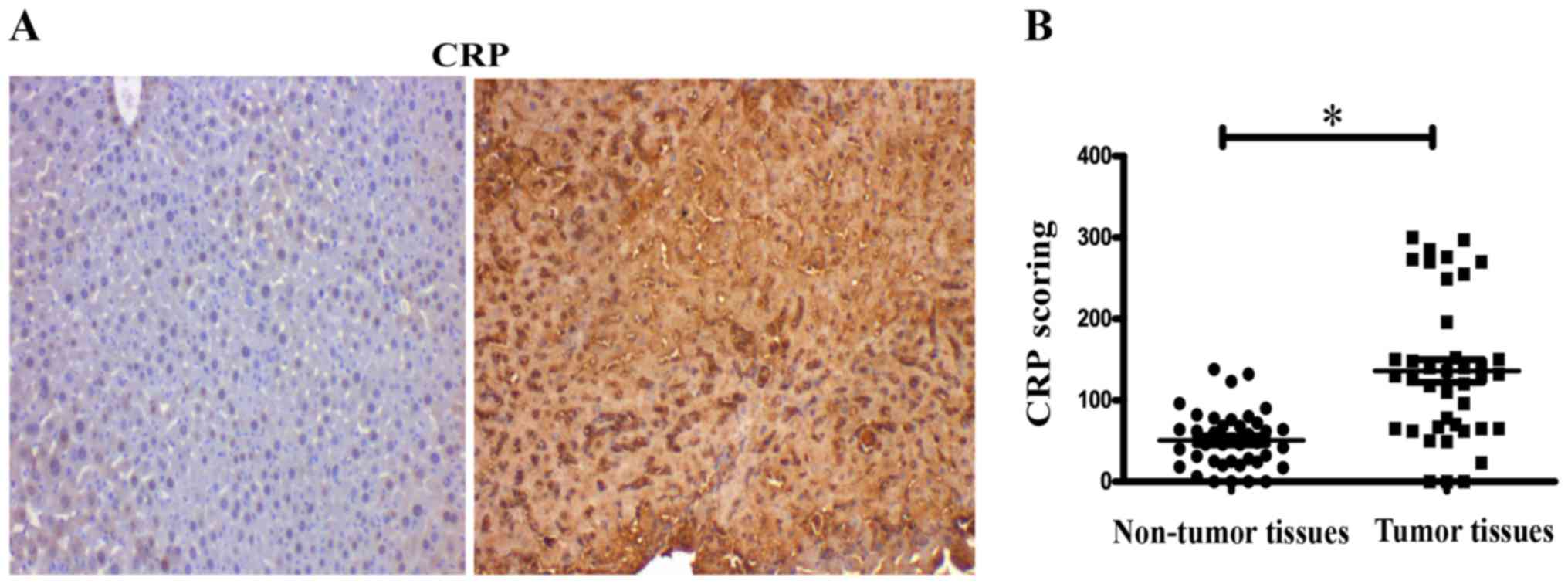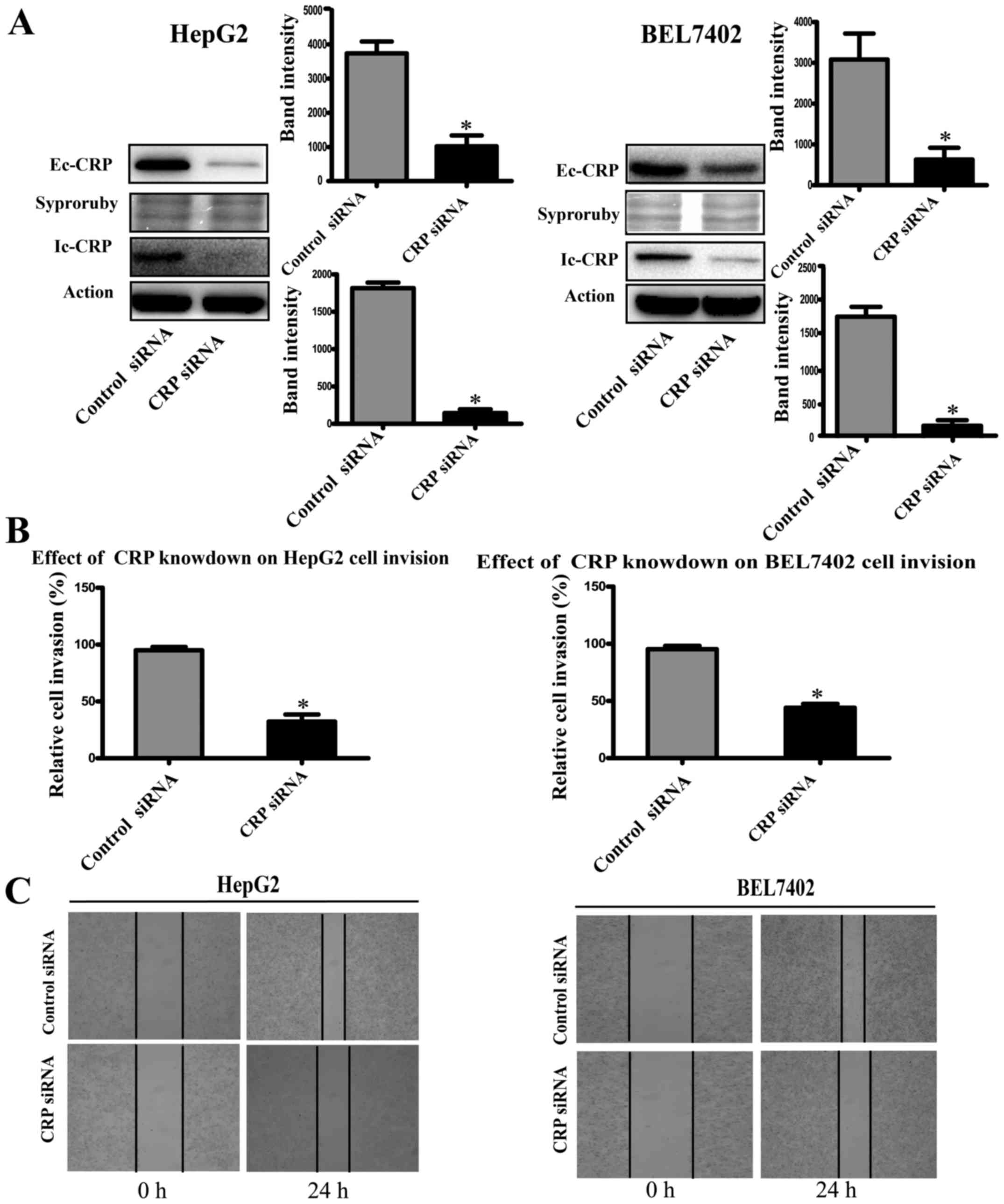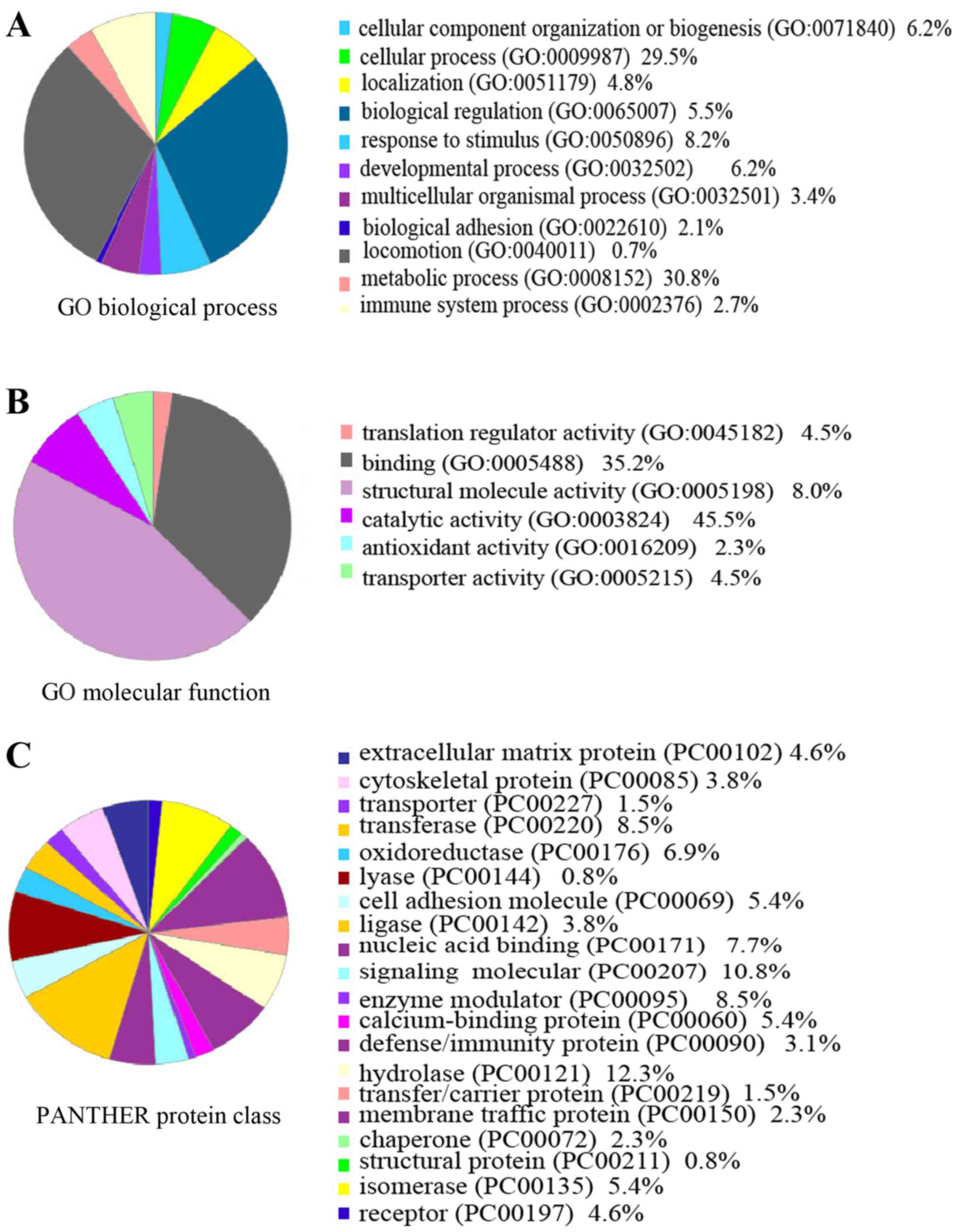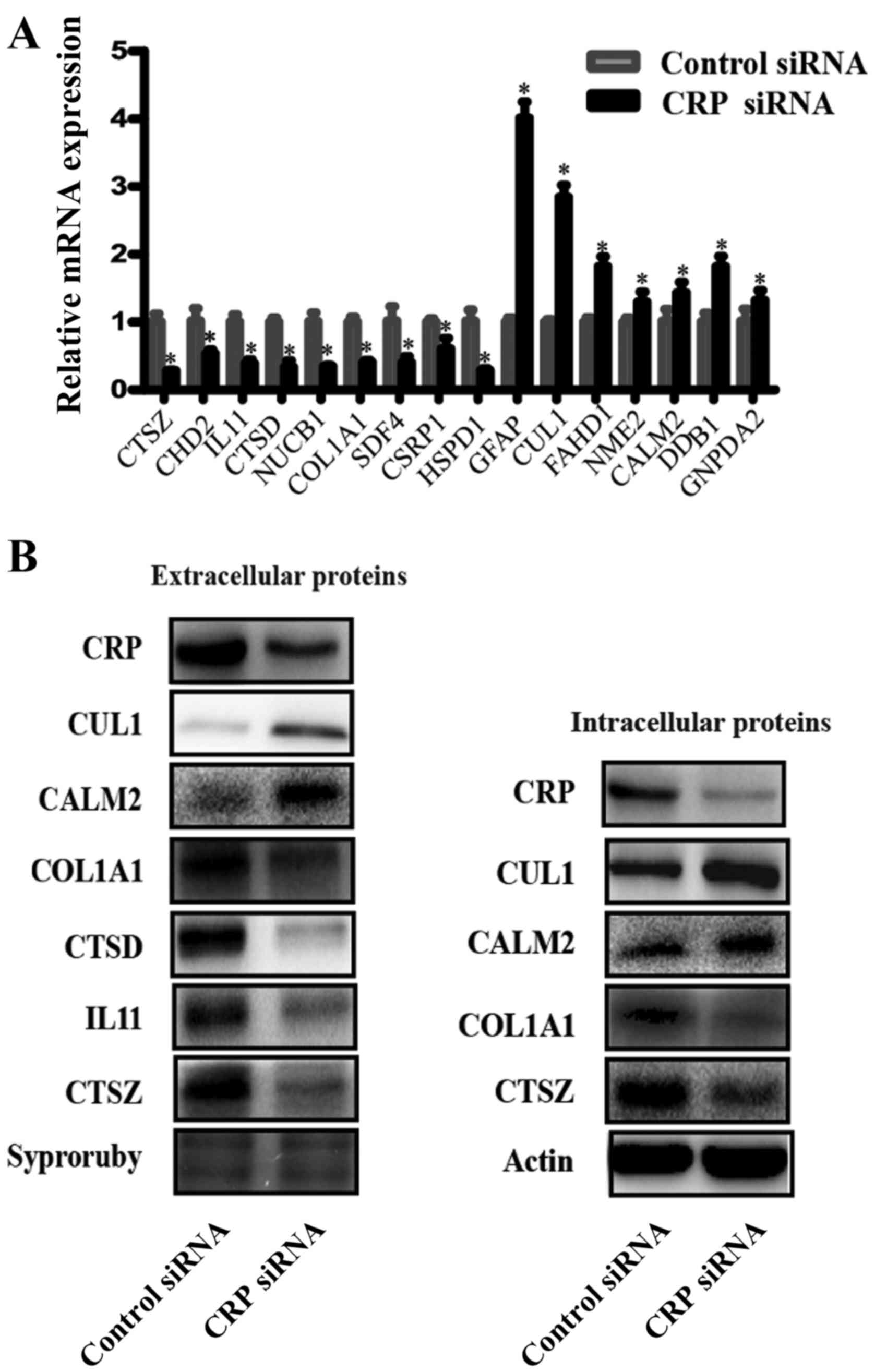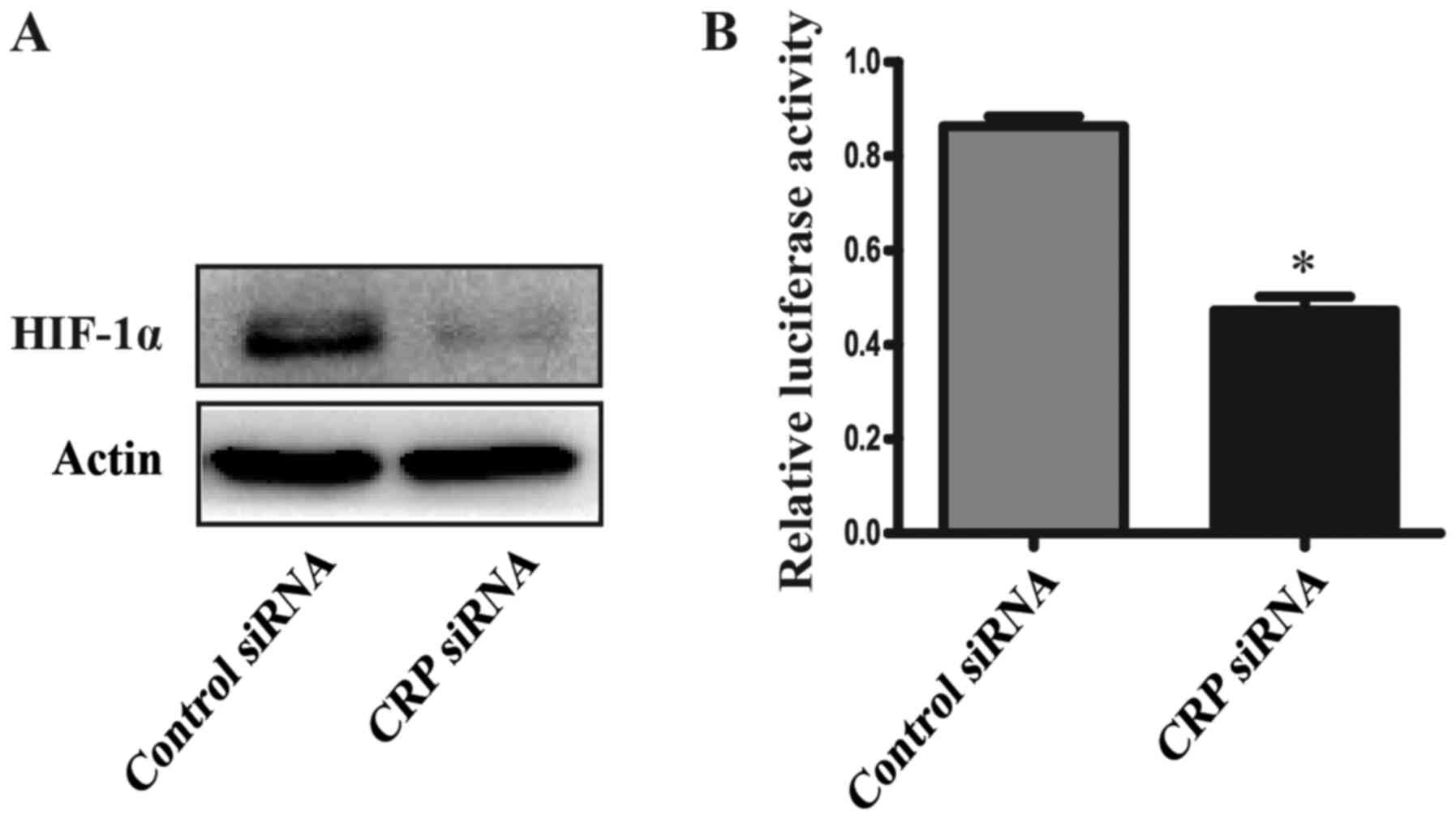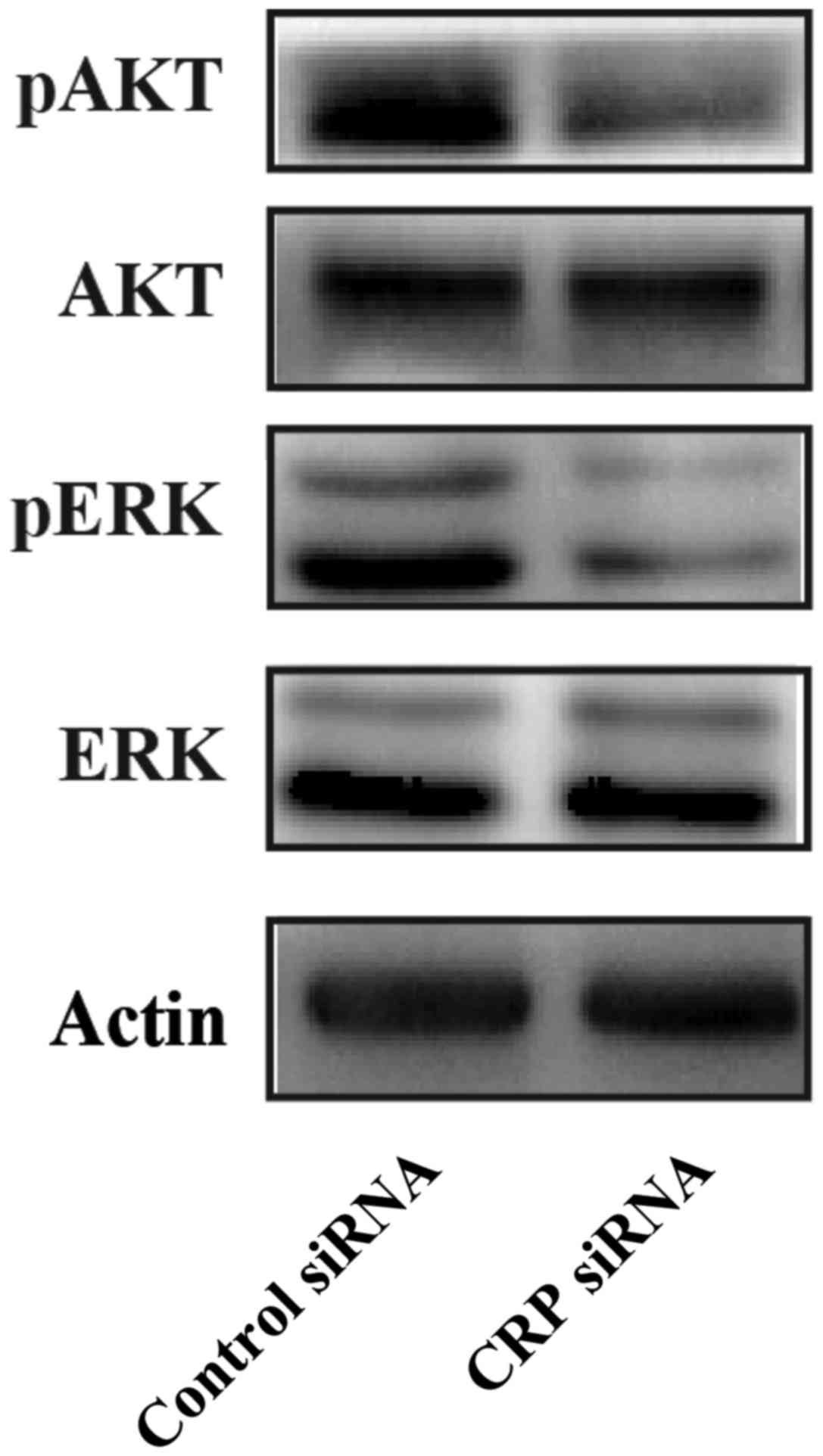Molecular mechanism of C-reaction protein in promoting migration and invasion of hepatocellular carcinoma cells in vitro
- Authors:
- Published online on: March 13, 2017 https://doi.org/10.3892/ijo.2017.3911
- Pages: 1289-1298
Abstract
Introduction
Hepatocellular carcinoma (HCC) is the fifth most common malignant cancer and the second leading cause of cancer related deaths globally (1,2). Despite the improvement of surgical techniques and adjuvant therapies, approximately 20% of HCC patients still suffer extra-hepatic metastases within 5–10 years of receiving radical surgical treatment. The long-term survival of patients with metastases remains low (3). Therefore, it is critical to discover the mechanisms underlying HCC metastasis.
C-reactive protein (CRP), a prototypic acute-phase protein and a member of the ancient and highly conserved proteins of the pentraxin family, has a cyclic pentameric structure. CRP is involved directly in a wide range of inflammatory processes and contributes to innate host immunity (4). Moreover, CRP is a sensitive systemic marker of inflammation and tissue damage. Elevated levels of CRP are detected in patients with infections, inflammatory diseases, or necrosis (5). Upregulation of CRP expression has been implicated in many types of tumors, including ovarian (6), lung (7), colon cancer (8), multiple myeloma (9) and lymphoma (10). Previous studies focused mostly on the expression level of CRP in cancer patients. Several studies have demonstrated that CRP promotes cell proliferation in endothelial cells, endothelial progenitor cells, renal tubular epithelial cells, and protects against apoptosis in myeloma cells (11,12), which are implicated in tumorigenesis and the development of HCC. Despite evidence of CRP being involved in a variety of cancers, the role of CRP in regulating HCC metastasis remains unclear.
Recently, the use of isobaric tags for relative and absolute quantitation (iTRAQ) technology has become a particularly powerful tool and has been recommended by the proteomics community to enable deeper proteome coverage, since it can facilitate simultaneous analysis of up to eight samples in one experiment. The aim of the present study was to use iTRAQ to identify alterations in the proteome of CRP siRNA treated samples, compared to control samples, in order to identify proteins participating in the migration and invasion of HCC.
In the present study, we hypothesized that CRP has an effect on invasion and metastasis of HCC. To elucidate the potential mechanism/pathway by which CRP contributes to migration and invasion, iTRAQ-based MS was performed to analyze differentially expressed proteins (DEPs) between the supernatants of CRP siRNA-treated supernatant and the negative siRNA-treated HepG2 cells.
Materials and methods
Immunohistochemistry (IHC) and tissue microarrays (TMA)
A commercial tissue microarray (BC03117; Us Biomax, Inc., Rockville, MD, USA), containing 40 cases of hepatocellular carcinoma and 40 matched cancer adjacent normal tissues, was used for IHC evaluation of CRP. Liver sections embedded in paraffin were deparaffinized in xylene, rehydrated in ethanol and washed in double-distilled H2O (13). Endogenous peroxidase activity was quenched by incubating the sections for 10 min in 3% H2O2, and the liver sections were then blocked with BSA for 30 min. The sections were incubated with primary antibodies against CRP (1:100 dilution) overnight at 4°C. IHC visualization of CRP was performed with an EnVision system with horseradish peroxidase (Dako Cytomation, Glostrup, Denmark) (13).
Cell lines
Human HCC cell lines, HepG2 (ATCC, Manassas, VA, USA) and the BEL7402 (Cell Bank of the Chinese Academy of Medical Science, Beijing, China), were cultured in an atmosphere of 5.0% carbon dioxide at 37°C in RPMI-1640 medium that was supplemented with 10% fetal bovine serum (FBS; Gibco, San Diego, CA, USA) and 100 IU/ml penicillin.
CRP siRNA transfection, Transwell assays and wound healing
HepG2 and BEL7402 cells were transfected with 100 nM of CRP specific Stealth Select RNAi™ siRNA (sc-40816) or a negative control siRNA (12935-400) using Lipofectamine 2000 (Invitrogen, Carlsbad, CA, USA), following the manufacturer's instructions. After transfection for 6 h, the culture medium was replaced with fresh RPMI-1640, supplemented with 10% FBS and penicillin, and the cells continued in culture for an additional 42 h. To explore the role of CRP in the in vitro progression of HCC, wound-healing, cell migration and invasion assays were conducted two days after transfection. The wound healing assays were performed in 6-well plates. As the cell reached confluence, a wound was incised in the cell monolayer using a sterile p200 pipette tip, followed by three washes with medium. Digital images of the wound areas were captured after 0 and 24 h, using a phase contrast microscope. The Transwell invasion assays were performed using a 24-well Cell Invasion Assay kit (Cell Biolabs, Inc., San Diego, CA, USA). Briefly, HepG2 cells were harvested and re-suspended in serum-free media until they were transfected with CRP or control siRNA for 48 h. Approximately 2×105 transfected cells were loaded into the upper chamber and 500 µl media (1640 plus 10% FBS) was loaded into the lower chambers. Cells were incubated for 24 h. The non-invasive cells were removed using cotton swabs, and the number of invading cells on the bottom of the filters were measured using CyQUANT GR fluorescent dye and detection at 560 nm. In each case, the silencing of CRP expression was verified by western blot analysis.
The HepG2 cell secretory proteins collection
Two days following HepG2 transfected with 100 nM of CRP specific Stealth Select RNAi™ siRNA (sc-40816) or a negative control siRNA, the culture medium was again replaced with fresh RPMI-1640 without FBS or penicillin and continued to culture for 2 days. Then the HepG2 cell culture medium without FBS or penicillin (secretory proteins) were concentrated and used for iTRAQ-coupled LC-MS/MS analyses.
ITRAQ labeling
The 8-plex iTRAQ kits were purchased from Applied Biosystems (Foster City, CA, USA). The secretory proteins was collected as described above and the protein concentrations were quantified by 2D Quant kit (Amersham Biosciences). Approximately 100 µg of protein from each sample was precipitated, dissolved in dissolution buffer, denatured, cysteine blocked, digested with 2 µg of sequencing grade modified trypsin and labeled using iTRAQ reagents as follows: negative control siRNA transfected protein, 113 and 116 tags; pooled CRP siRNA-treated protein, 115 and 117 tags: pooled negative siRNA-treated protein. The labeled samples were combined before analysis.
Peptide fractionation
The method of peptide fractionation was immobilized-pH-gradient isoelectric focusing (IPG-IEF), as previously described (14,15). Briefly, the pooled iTRAQ-labeled samples were solubilized in Pharmalyte (Amersham Biosciences) and 8 M urea, rehydrated on 18 cm-long IPG gel strips (pH 3–10; Amersham Biosciences), and then subjected to IEF focusing at 68 kV/h with an IPGphor System (GE Healthcare). Peptides were extracted by incubating the gel pieces in acetonitrile and formic acid. The pieces were purified and concentrated on a C18 Discovery DSC-18 SPE column (Sigma-Aldrich), lyophilized and stored at −20°C until LC-MS/MS analysis.
Mass spectrometry
A QStar Elite mass spectrometer (Applied Biosystems) coupled with an Dionex UltiMate 3000 liquid chromatography system (Thermo Fisher Scientific, Amsterdam, The Netherlands) was used for mass spectrometric analysis (16). Peptide separation was carried out on a C18 analytical column (Thermo Fisher Scientific, Beijing, China). Purified peptide fractions were dissolved in buffer A (98% ACN), loaded onto a C18 trap column and subsequently eluted from the trap column over the C18 analytical column at a flow rate of 300 nl/min in 125 min linear gradient ranging from 2 to 100% mobile phase B (0.1% formic acid, 98% acetonitrile). Data acquisition was done in the positive ion mode, with a selected mass range of 300–1800 m/z. The two most abundantly charged ions which exceeded 20 counts were chosen for MS/MS at a dynamic exclusion of 30 sec (17). Protein identification and quantification were performed with ProteinPilot v2.0 (AB Sciex). MS/MS data were processed by searching the International Protein Index (IPI) human database v3.77. Methyl methane thiosulfate (MMTS) modified cysteine was specified as a fixed modification. Proteins having at least two unique peptides with fold-change >1.3 or <0.77 (P<0.05) between two stages were considered to be differentially expressed proteins.
Bioinformatics
Gene Ontology analysis was performed using PANTHER (http://www.pantherdb.org/) to classify biological processes, protein classes and molecular functions.
RNA extraction and quantitative RT-PCR
Total RNA was extracted from HepG2 cells with TRIzol reagent (Gibco-BRL, Gaithersburg, MD, USA), according to the manufacturer's instructions. First-strand cDNA was synthesized using a Thermo Scientific RevertiAid First Strand cDNA synthesis kit (Thermo Fisher Scientific). RT-PCR was performed on an ABI 7900HT system using the KAPA SYBR® FAST Universal 2X qPCR Master Mix and primers for GAPDH (Hs00486019_CE), GFAP (Hs00167550_CE), CUL1 (Hs00667710_CE), FAHD1 (Hs00636334_CE), NME2 (Hs00543451_CE), GNPDA2 (Hs00831453_CE), CALM2 (Hs00710519_CE), DDB1 (Hs00586106_CE), HSPD1 (Hs00830627_CE), CTSZ (Hs00664339_CE), CDH2 (Hs00805624_CE), IL11 (Hs00545902_CE), (Hs00829008_ CE), NUCB1 (Hs00817382_CE), COL1A1 (Hs00747266_CE), SDF4 (Hs00796825_CE) and CSRP1 (Hs00723484_CE). The relative changes of gene expression were calculated according to the 2−ΔΔCT quantification method (18).
Western blotting
HepG2 cells were lysed with a non-ionic detergent (NID) lysis buffer. The resulting soluble cell extract was centrifuged for 30 min at 12,000 × g and the intracellular protein was collected. Additional, the secretory proteins was concentrated for 30 min at 3400 × g using an ultra-filtration centrifuge tube, after which the extracellular protein was collected. The intracellular and extracellular protein concentrations were determined using a 2-D Quant kit (GE Healthcare). Protein (40 µg) was separated by SDS-PAGE and transferred to PVDF membranes (Amersham Biosciences). Membranes were blocked for 1 h with 5% non-fat powdered milk in TBS-T buffer (pH 7.6, 0.5% Tween-20), then incubated overnight with primary antibodies at 4°C. These monoclonal antibodies against CRP, CTSZ, IL11, CTSD, COL1A1, CUL1, CALM2, HIF-1α, p-AKT, AKT, p-ERK, ERK and actin (Abcam, Cambridge, MA, USA) were diluted from 1:2,000 to 1:10,000. After washing three times with TBS-T buffer, the membranes were incubated with a horseradish peroxidease-conjugated (HRP) goat anti-rabbit IgG or goat anti-mouse IgG (Santa Cruz Biotechnology) as the secondary antibody (1:5,000 dilution) for 1 h at room temperature. The membranes were washed again three times with TBS-T buffer and visualized with the ChemiDoc MP Imaging system (Bio-Rad Laboratories, Hercules, CA, USA).
The detection of HIF-1α luciferase activity
HepG2 cells transfected with either CRP siRNA or control siRNA were plated into 24-well plates. After 24 h of transfection, the HepG2 cells were co-transfected with 500 ng of plasmid pGL3 and 15 ng of pRL-SV40 using Lipofectamine 2000. After transfection for additional 24 h, the Luciferase activity of HIF-1α was determined on a GloMax 20/20 using the Dual-luciferase assay kit (Promega GmbH, Mannheim, Germany). Firefly luciferase units were normalized with Renilla luciferase carried by pRL-SV40 plasmid. Each experiment was performed in triplicate.
Statistical analysis
The experimental data are presented as the mean ± standard deviation (SD), and differences between the two groups were analyzed using the Student's t-test. P<0.05 was considered statistically significant. SPSS software v16.0 (SPSS, Inc., Chicago, IL, USA) was used for the analyses.
Results
Overexpression of CRP in hepatocellular carcinoma tissues
The expression of CRP was assessed in tissue microarrays, containing 40 cases of hepatocellular carcinoma and 40 matched adjacent normal tissue by IHC. IHC evaluation of tissue microarrays showed that expression of CRP was significantly stronger in tumor tissues than in normal tissues (P<0.05) (Fig. 1A). IHC score values of CRP were significantly higher in the HCC tissues than in the HCC adjacent normal tissues (P<0.05) (Fig. 1B).
CRP inhibits HCC cell migration, invasion and wound healing
To study the role of CRP in tumor cell motility, we used CRP-specific siRNA to silence CRP expression in HCC cell lines (HepG2 and BEL7402). Western blot analysis showed that CRP siRNA-treated cell lines downregulated CRP expression significantly (Fig. 2A). The invasion assay demonstrated that the downregulation of CRP markedly weakened the migration and invasion capabilities of HepG2 and BEL7402 cells by 63 and 50%, respectively (P<0.05) (Fig. 2B). Similarly, the ability to close scratch wounds was decreased in HepG2 and BEL7402 cells (Fig. 2C).
Analysis of iTRAQ data of aberrantly expressed proteins
To investigate the molecular mechanism of CRP in the suppression of HCC migration and invasion, we conducted iTRAQ-based MS to analyze secretory proteins from CRP siRNA-treated and negative control siRNA-treated HepG2 cells. The ratio of 115:113 and 117:116 expressed the relative protein expression in the CRP siRNA-treated and negative control siRNA-treated secretory proteins. Hundreds of proteins were identified by ProteinPilot 2.0 software. The protein threshold was set to achieve 95% confidence at 5% FDR (false discovery rate). To define the differentially expressed proteins (DEPs), we introduced an additional ±1.3-fold cut-off for all iTRAQ ratios (19,20). Using this value, the overall data from technical replicate analyses produces <30% variation. A total of 401 unique proteins were confidently identified and quantified, regardless of whether the P-value was <0.05 in the iTRAQ ratios. Of the 109 proteins expressed differentially between the CRP siRNA-treated samples and the negative control siRNA-treated samples, 45 proteins were overexpressed and 64 were downregulated. The top 30 upregulated and downregulated proteins are shown in Table I.
Table IThe top 30 upregulated and downregulated differentially expressed proteins, as identified using iTRAQ technology. |
Cellular and molecular functional characteristics of the differentially expressed proteins
To better identify the functional characteristics of the 109 DEPs, these proteins were grouped by PANTHER Classification System according to their reported biological process, protein class and molecular functions. Gene Ontology analysis with PANTHER suggested that the DEPs was found to represent a total of 11 biological processes, 20 protein classes and 6 molecular functions (Fig. 3). Metabolic, cellular and developmental processes were the most common biological processes reported.
Validation of differentially expressed proteins
To validate the reliability of the iTRAQ analysis data, we chose samples used in the iTRAQ assays and conducted western blotting and RT-PCR to detect the extracellular levels of several DEPs. Fig. 4A shows the relative mRNA expression levels of CTSZ, CDH2, IL11, CTSD, NUCB1, COL1A1, SDF4, CSRP1, HSPD1, GFAP, CUL1, FAHD1, NME2, CALM2, DDB1, and GNPDA2 as normalized to GADPH. RT-PCR showed the mRNA levels of CTSZ, CDH2, IL11, CTSD, NUCB1, COL1A1, SDF4, CSRP1 and HSPD1 were downregulated, whereas the mRNA levels of GFAP, CUL1, FAHD1, NME2, CALM2, DDB1 and GNPDA2 were upregulated in the CRP siRNA-treated samples, compared to the negative control siRNA-treated samples. The trend was consistent with the results of the iTRAQ approach. In order to validate the levels of several proteins, western blot analyses were performed. Fig. 4B shows the western blot analysis results of CTSZ, IL11, CTSD, COL1A1 CUL1 and CALM2 expression in intracellular and extracellular samples. Supernatant protein from CRP siRNA-treated cells had obviously decreased expression levels of CTSZ, IL11, CTSD, COL1A1 and increased expression levels of CUL1 and CALM2, compared to negative control siRNA-treated cells. IL11 and CTSD are, intracellularly, low expression proteins, thus, these were not detected in the western blot analyses. In addition to these two proteins, other proteins are similarly expressed intracellularly.
CRP knockdown downregulates HIF-1α expression and the luciferase activity of HIF-1α in HepG2 cells
Because CRP could affect the activity of HIF-1α, which has also been shown to induce expression of CTSD (21). CTSD accociated with the growth, proliferation and metastasis of tumors (22). The expression and luciferase activity of HIF-1α was determined using the western blot analyses and Dual-luciferase reporter assay system. Our results showed that the expression and luciferase activity of HIF-1α was significantly reduced in CRP siRNA treated HepG2 cells, compared to the control group (Fig. 5).
CRP knockdown suppresses ERK and Akt phosphorylation in HepG2 cells
MEK/ERK and PI3K/AKT signaling pathways play important roles in migration, invasion and metastasis of cancer (23). CRP could upregulate VEGF-A expression via the MEK/ERK and PI3K/AKT signaling pathways in adipose-derived stem cells (24). We hypothesize that CRP promotes migration, invasion, and metastasis of HCC through MEK/ERK and PI3K/AKT signaling pathways. We observed that the downregulation of CRP remarkably inhibits ERK and Akt phosphorylation at the protein level when compared to control siRNA in HepG2 cells (Fig. 6). These results indicate that CRP may induce cell migration, and invasion through MEK/ERK and PI3K/AKT signaling pathways.
Discussion
Using proteomic strategies, a growing body of evidence has identified proteins specifically upregulated or downregulated in HCC tissues that can be considered as early diagnostic markers, prognostic markers and therapeutic targets (25,26). CRP is such a protein overexpressed in various types of tumors (6–10), and is a promising biomarker of HBV-related HCC (27). However, little is known about the function of CRP in HCC cells.
The present study demonstrates that CRP was significantly overexpressed in HCC tissues compared to non-cancerous tissues. Extra-hepatic metastases of HCC, which is the main cause of cancer-related death, depend largely on the migratory and invasive capabilities of HCC cells. Several studies have demonstrated that CRP promoted cell proliferation in endothelial cells, endothelial progenitor cells, renal tubular epithelial cells and provided protection from apoptosis in myeloma cells, in vitro and in vivo (11,12). Here, we demonstrated that CRP knockdown in HepG2 and BEL7402 cells significantly suppressed cell growth, migration and invasion in vitro, as shown in wound assays and Transwell assays. Our findings provide the first piece of evidence that CRP silencing inhibited migration and invasion, suggesting a carcinogenic role for CRP in HCC.
To investigate the potential molecular mechanism by which CRP contributes to migration and invasion, iTRAQ-based MS was performed to analyze secretory DEPs between CRP siRNA-treated and negative siRNA-treated HepG2 cells. Our iTRAQ analysis identified 109 aberrantly expressed proteins in CRP siRNA-treated samples. Many of them, including CTSZ, IL11, CTSD, COL1A1, CUL1 and CALM2, were identified using western blot analysis and RT-PCR analyses. The data indicated that the iTRAQ technology is both reliable and powerful for protein quantification. Among these proteins, we focused on cathepsin D (CTSD) because the expression of CTSD was obviously downregulated in CRP siRNA-treated samples, compared to control negative siRNA-treated samples, and is closely associated with invasion and metastasis of cancer cells.
Cathepsin D, a member of the aspartic proteinase super-family in the lysosomes of eukaryotic cells (28), degrades the extracellular matrix (ECM) and is overexpressed and hyper-secreted by carcinoma cells (29). Accumulated data show that CTSD is secrected in breast, prostate, ovaria, and lung cancer cell lines, and acts as a autocrine cancer cell growth factor involving cancer development (30). In addition, CTSD correlates with poor prognoses, invasion and metastasis in many malignancies (22,31,32). Several possible mechanisms have been proposed. For instance, CTSD promotes angiogenesis by releasing basic fibroblast growth factor (33). Additionally, CTSD can degrade anti-angiogenesis growth factors, such as angiogenesis inhibitor 16K prolactin and endostatin (34). HIF1, a transcription factor, is one of the important players in modulation of cell metabolism and plays an essential role in cellular and systemic homeostatic responses to hypoxia. HIF-1α in itself induces expression of several glycolytic enzymes, as well as inhibits entry into the TCA-cycle (35). Several studies have shown that high expression of HIF-1α correlated with a short survival in non-small cell lung cancer (NSCLC) (36–38). HIF-1α has also been shown to induce expression ofCTSD (21). Based on the close relationship between HIF-1α and CTSD, and the observation that CTSD was significantly decreased when CRP was silenced. We further measured expression and activity of HIF-1α. Our result showed that expression and luciferase activity of HIF-1α was decreased in CRP siRNA treated HepG2 cells. Thus, we hypothesized that when silencing CRP, the decrease in CTSD may be through this pathway.
It has been reported that activation of MEK/ERK and PI3K/AKT signaling pathways play important roles in migration, invasion and metastasis of cancer (23). CRP could upregulate VEGF-A expression by activating HIF-1α via the MEK/ERK and PI3K/AKT signaling pathways in adipose-derived stem cells (ADSCs) (24). However, few studies have reported on the relationship of CRP and MEK/ERK and PI3K/AKT signaling pathways in HCC. Therefore, we investigated whether CRP was capable of promoting migration, invasion via the MEK/ERK and PI3K/AKT pathway in HCC cells. Our results showed that CRP knockdown remarkably inhibits ERK and Akt phosphorylation at the protein level when compared to control siRNA in HepG2 cells. Therefore, our data support that activation of MEK/ERK and PI3K/AKT signaling pathways may required for CRP-stimulated cell migration and invasion of HCC cells.
In conclusion, we have demonstrated that CRP is highly expressed in tumor tissues and promotes invasion and metastases in HCC cell lines. In addition, we have performed a quantitative proteomic profiling of supernatant proteins from CRP siRNA-treated and negative control siRNA-treated HepG2 cells. We observed 109 aberrantly expressed proteins in CRP siRNA-treated samples. Moreover, silencing of CRP abrogates HIF-1α expression levels, the luciferase activity of HIF-1α, and ERK and Akt phosphorylation in HepG2 cells. The present study provides a novel mechanism by which CRP promotes the proliferation, migration, invasion, metastasis of hepatocellular carcinoma cells. Inhibition of CRP could suppress migration, invasion and healing of hepatoma carcinoma cells by decreasing HIF-1α activity and CTSD.
Acknowledgments
The present study was supported by the National Natural Science Foundation of China (81171560), the National Key Technology Support Program (2012BAI35B03), the 'Par-Eu Scholars Program' of Chongqing City, the National Science and Technology Major Project of China (2012ZX10002007001), the Chongqing Natural Science Foundation, the Chongqing Municipal Science and Technology (no. cstc2012jjA10064), and the Natural Science Foundation Project of CQ CSTC (2013jcyjA10060).
References
|
El-Serag HB: Epidemiology of viral hepatitis and hepatocellular carcinoma. Gastroenterology. 142:1264–1273.e1. 2012. View Article : Google Scholar : PubMed/NCBI | |
|
El-Serag HB and Kanwal F: Epidemiology of hepatocellular carcinoma in the United States: Where are we? Where do we go? Hepatology. 60:1767–1775. 2014. View Article : Google Scholar : PubMed/NCBI | |
|
Ren W, Qi X, Jia J, Yang M and Han G: Hepatocellular carcinoma. Lancet (London, England). 380:469author reply 470–461. 2012. View Article : Google Scholar | |
|
Stein MP, Edberg JC, Kimberly RP, Mangan EK, Bharadwaj D, Mold C and Du Clos TW: C-reactive protein binding to FcgammaRIIa on human monocytes and neutrophils is allele-specific. J Clin Invest. 105:369–376. 2000. View Article : Google Scholar : PubMed/NCBI | |
|
Pepys MB: C-reactive protein: The role of an ancient protein in modern rheumatology. Clin Exp Rheumatol. 1:3–7. 1983.PubMed/NCBI | |
|
Hefler LA, Concin N, Hofstetter G, Marth C, Mustea A, Sehouli J, Zeillinger R, Leipold H, Lass H, Grimm C, et al: Serum C-reactive protein as independent prognostic variable in patients with ovarian cancer. Clin Cancer Res. 14:710–714. 2008. View Article : Google Scholar : PubMed/NCBI | |
|
Xu M, Zhu M, Du Y, Yan B, Wang Q, Wang C and Zhao J: Serum C-reactive protein and risk of lung cancer: A case-control study. Med Oncol. 30:3192013. View Article : Google Scholar | |
|
Chung YC and Chang YF: Serum C-reactive protein correlates with survival in colorectal cancer patients but is not an independent prognostic indicator. Eur J Gastroenterol Hepatol. 15:369–373. 2003. View Article : Google Scholar : PubMed/NCBI | |
|
Bataille R, Boccadoro M, Klein B, Durie B and Pileri A: C-reactive protein and beta-2 microglobulin produce a simple and powerful myeloma staging system. Blood. 80:733–737. 1992.PubMed/NCBI | |
|
Legouffe E, Rodriguez C, Picot MC, Richard B, Klein B, Rossi JF and Commes T: C-reactive protein serum level is a valuable and simple prognostic marker in non Hodgkin's lymphoma. Leuk Lymphoma. 31:351–357. 1998. View Article : Google Scholar : PubMed/NCBI | |
|
Yang J, Wezeman M, Zhang X, Lin P, Wang M, Qian J, Wan B, Kwak LW, Yu L and Yi Q: Human C-reactive protein binds activating Fcgamma receptors and protects myeloma tumor cells from apoptosis. Cancer Cell. 12:252–265. 2007. View Article : Google Scholar : PubMed/NCBI | |
|
Liu F, Chen HY, Huang XR, Chung AC, Zhou L, Fu P, Szalai AJ and Lan HY: C-reactive protein promotes diabetic kidney disease in a mouse model of type 1 diabetes. Diabetologia. 54:2713–2723. 2011. View Article : Google Scholar : PubMed/NCBI | |
|
Ho J, Kong JW, Choong LY, Loh MC, Toy W, Chong PK, Wong CH, Wong CY, Shah N and Lim YP: Novel breast cancer metastasis-associated proteins. J Proteome Res. 8:583–594. 2009. View Article : Google Scholar | |
|
Hu H, Ding X, Yang Y, Zhang H, Li H, Tong S, An X, Zhong Q, Liu X, Ma L, et al: Changes in glucose-6-phosphate dehydrogenase expression results in altered behavior of HBV-associated liver cancer cells. Am J Physiol Gastrointest Liver Physiol. 307:G611–G622. 2014. View Article : Google Scholar : PubMed/NCBI | |
|
Ran X, Xu X, Yang Y, She S, Yang M, Li S, Peng H, Ding X, Hu H, Hu P, et al: A quantitative proteomics study on olfactomedin 4 in the development of gastric cancer. Int J Oncol. 47:1932–1944. 2015.PubMed/NCBI | |
|
Wang LN, Tong SW, Hu HD, Ye F, Li SL, Ren H, Zhang DZ, Xiang R and Yang YX: Quantitative proteome analysis of ovarian cancer tissues using a iTRAQ approach. J Cell Biochem. 113:3762–3772. 2012. View Article : Google Scholar : PubMed/NCBI | |
|
Yang Y, Toy W, Choong LY, Hou P, Ashktorab H, Smoot DT, Yeoh KG and Lim YP: Discovery of SLC3A2 cell membrane protein as a potential gastric cancer biomarker: Implications in molecular imaging. J Proteome Res. 11:5736–5747. 2012.PubMed/NCBI | |
|
Livak KJ and Schmittgen TD: Analysis of relative gene expression data using real-time quantitative PCR and the 2(−Delta Delta C(T)) method. Methods. 25:402–408. 2001. View Article : Google Scholar | |
|
Gan CS, Chong PK, Pham TK and Wright PC: Technical, experimental, and biological variations in isobaric tags for relative and absolute quantitation (iTRAQ). J Proteome Res. 6:821–827. 2007. View Article : Google Scholar : PubMed/NCBI | |
|
Zhou C, Simpson KL, Lancashire LJ, Walker MJ, Dawson MJ, Unwin RD, Rembielak A, Price P, West C, Dive C, et al: Statistical considerations of optimal study design for human plasma proteomics and biomarker discovery. J Proteome Res. 11:2103–2113. 2012. View Article : Google Scholar : PubMed/NCBI | |
|
Krishnamachary B, Berg-Dixon S, Kelly B, Agani F, Feldser D, Ferreira G, Iyer N, LaRusch J, Pak B, Taghavi P, et al: Regulation of colon carcinoma cell invasion by hypoxia-inducible factor 1. Cancer Res. 63:1138–1143. 2003.PubMed/NCBI | |
|
Dian D, Heublein S, Wiest I, Barthell L, Friese K and Jeschke U: Significance of the tumor protease cathepsin D for the biology of breast cancer. Histol Histopathol. 29:433–438. 2014. | |
|
Yoo YA, Kang MH, Lee HJ, Kim BH, Park JK, Kim HK, Kim JS and Oh SC: Sonic hedgehog pathway promotes metastasis and lymphangiogenesis via activation of Akt, EMT, and MMP-9 pathway in gastric cancer. Cancer Res. 71:7061–7070. 2011. View Article : Google Scholar : PubMed/NCBI | |
|
Chen J, Gu Z, Wu M, Yang Y, Zhang J, Ou J, Zuo Z, Wang J and Chen Y: C-reactive protein can upregulate VEGF expression to promote ADSC-induced angiogenesis by activating HIF-1α via CD64/PI3k/Akt and MAPK/ERK signaling pathways. Stem Cell Res Ther. 7:1142016. View Article : Google Scholar | |
|
Lee IN, Chen CH, Sheu JC, Lee HS, Huang GT, Chen DS, Yu CY, Wen CL, Lu FJ and Chow LP: Identification of complement C3a as a candidate biomarker in human chronic hepatitis C and HCV-related hepatocellular carcinoma using a proteomics approach. Proteomics. 6:2865–2873. 2006. View Article : Google Scholar : PubMed/NCBI | |
|
Feng JT, Liu YK, Song HY, Dai Z, Qin LX, Almofti MR, Fang CY, Lu HJ, Yang PY and Tang ZY: Heat-shock protein 27: A potential biomarker for hepatocellular carcinoma identified by serum proteome analysis. Proteomics. 5:4581–4588. 2005. View Article : Google Scholar : PubMed/NCBI | |
|
She S, Xiang Y, Yang M, Ding X, Liu X, Ma L, Liu Q, Liu B, Lu Z, Li S, et al: C-reactive protein is a biomarker of AFP-negative HBV-related hepatocellular carcinoma. Int J Oncol. 47:543–554. 2015.PubMed/NCBI | |
|
Westley B and Rochefort H: A secreted glycoprotein induced by estrogen in human breast cancer cell lines. Cell. 20:353–362. 1980. View Article : Google Scholar : PubMed/NCBI | |
|
Rochefort H, Capony F, Garcia M, Cavaillès V, Freiss G, Chambon M, Morisset M and Vignon F: Estrogen-induced lysosomal proteases secreted by breast cancer cells: A role in carcinogenesis? J Cell Biochem. 35:17–29. 1987. View Article : Google Scholar : PubMed/NCBI | |
|
Berchem G, Glondu M, Gleizes M, Brouillet JP, Vignon F, Garcia M and Liaudet-Coopman E: Cathepsin-D affects multiple tumor progression steps in vivo: Proliferation, angiogenesis and apoptosis. Oncogene. 21:5951–5955. 2002. View Article : Google Scholar : PubMed/NCBI | |
|
Vashishta A, Ohri SS, Proctor M, Fusek M and Vetvicka V: Ribozyme-targeting procathepsin D and its effect on invasion and growth of breast cancer cells: An implication in breast cancer therapy. Int J Oncol. 30:1223–1230. 2007.PubMed/NCBI | |
|
Glondu M, Liaudet-Coopman E, Derocq D, Platet N, Rochefort H and Garcia M: Down-regulation of cathepsin-D expression by antisense gene transfer inhibits tumor growth and experimental lung metastasis of human breast cancer cells. Oncogene. 21:5127–5134. 2002. View Article : Google Scholar : PubMed/NCBI | |
|
Briozzo P, Badet J, Capony F, Pieri I, Montcourrier P, Barritault D and Rochefort H: MCF7 mammary cancer cells respond to bFGF and internalize it following its release from extracellular matrix: A permissive role of cathepsin D. Exp Cell Res. 194:252–259. 1991. View Article : Google Scholar : PubMed/NCBI | |
|
Piwnica D, Fernandez I, Binart N, Touraine P, Kelly PA and Goffin V: A new mechanism for prolactin processing into 16K PRL by secreted cathepsin D. Mol Endocrinol. 20:3263–3278. 2006. View Article : Google Scholar : PubMed/NCBI | |
|
Keith B, Johnson RS and Simon MC: HIF1α and HIF2α: Sibling rivalry in hypoxic tumour growth and progression. Nat Rev Cancer. 12:9–22. 2011.PubMed/NCBI | |
|
Hung JJ, Yang MH, Hsu HS, Hsu WH, Liu JS and Wu KJ: Prognostic significance of hypoxia-inducible factor-1alpha, TWIST1 and Snail expression in resectable non-small cell lung cancer. Thorax. 64:1082–1089. 2009. View Article : Google Scholar : PubMed/NCBI | |
|
Kim SJ, Rabbani ZN, Dewhirst MW, Vujaskovic Z, Vollmer RT, Schreiber EG, Oosterwijk E and Kelley MJ: Expression of HIF-1alpha, CA IX, VEGF, and MMP-9 in surgically resected non-small cell lung cancer. Lung Cancer. 49:325–335. 2005. View Article : Google Scholar : PubMed/NCBI | |
|
Giatromanolaki A, Koukourakis MI, Sivridis E, Turley H, Talks K, Pezzella F, Gatter KC and Harris AL: Relation of hypoxia inducible factor 1 alpha and 2 alpha in operable non-small cell lung cancer to angiogenic/molecular profile of tumours and survival. Br J Cancer. 85:881–890. 2001. View Article : Google Scholar : PubMed/NCBI |



